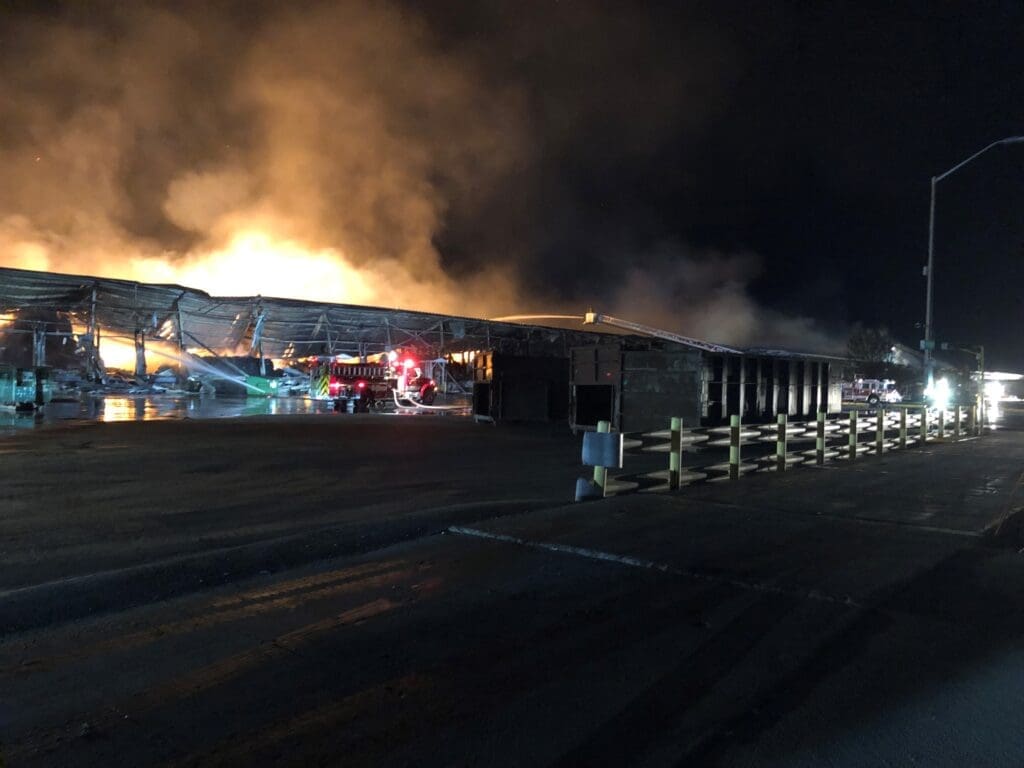
When a large fire broke out at an industrial warehouse in Menominee, Michigan in October of this year, first responders quickly realized the incident was one they would be unable to handle alone. As is often the case when battling a large fire, the Menominee Fire Department put out a call for help from other departments. However, given Menominee’s location in comparison to the rest of Michigan, help from within the state may have to come from several hours away.
“A lot of Michigan’s big resources are in the lower part of the state, which is four to five hours away,” said Marinette County Emergency Manager Kathy Frank, whose Wisconsin county shares a border with Menominee. “They were tapping a lot of Michigan resources in the upper peninsula already, but a lot of those are volunteer forces that are small and don’t have the capability to send full crews for days at a time.”
Many fire departments rely on existing agreements through the Mutual Aid Box Alarm System (MABAS), an organization that allows participating departments to share resources when responding to a fire or other incident. However, MABAS is designed for the in-state movement of fire department assets, which presented a problem for Menominee fire officials as they began looking for assistance from Wisconsin communities.
To help make more resources available, Michigan activated the Northern Emergency Management Assistance Compact (NEMAC). Ratified by Congress in 2013, NEMAC allows cross border mutual aid assistance between 10 U.S. states and four Canadian provinces that share borders. The agreement helps provide assurances for agencies that they can be reimbursed for costs associated with responding to an incident and that their personnel will be protected if injured.
“NEMAC is meant for situations just like this, so that we can help each other across borders,” said Wisconsin Emergency Management Administrator Greg Engle. “Having the compact in place allowed both states to approve the deployment across the border with just a quick phone call, and Wisconsin fire departments were able to send teams and equipment up into Michigan within hours.”
Wisconsin MABAS and the Wisconsin Fire Service Emergency Response Plan were utilized to quickly identify resources that were available to assist Michigan. This existing structure allowed for the quick coordination of assets to meet the needs identified by the state of Michigan, which were then requested using NEMAC.
Overall, 15 Wisconsin fire departments answered the call to send strike teams to Menominee under NEMAC, providing firefighters and other essential equipment. Responding departments included the town of Peshtigo, city of Peshtigo, Grover Porterfield, Wausaukee, Oconto, Oconto Falls, Gillet, Appleton, Suamico, Lawrence, Wayside, Greenleaf, Pulaski, and Howard. The City of Marinette Fire Department also responded under an existing mutual aid agreement. The Wisconsin Department of Natural Resources and Department of Health Services were also engaged in the response.
“I want to thank all of the first responders from Wisconsin who joined forces with Michigan to assist with extinguishing this fire, preventing it from spreading further, and providing relief to the firefighters in Michigan who had already been battling this fire for several days”, said Capt. Kevin Sweeney, Deputy State Director of Emergency Management and commander of the Emergency Management and Homeland Security Division, Michigan State Police.
“In addition to local mutual aid agreements, the Northern Emergency Management Assistance Compact agreement afforded Administrator Engle and I to move quickly to deploy much needed fire resources from Wisconsin, across the border into Menominee County, and the city of Menominee,” Sweeney added. “Continued communications, relationship building, training and exercising will only work to strengthen this compact.”
The fire in Menominee burned for 16 days and destroyed large portions of a 560,000-square-foot warehouse. Frank, who has worked with Menominee County on past responses that required cross-border coordination with Marinette County, believes NEMAC was critical to getting the fire out as quickly as they were able to.
“Being able to pull in Wisconsin fire departments was big,” Frank said. “I’m really glad NEMAC was there.”

